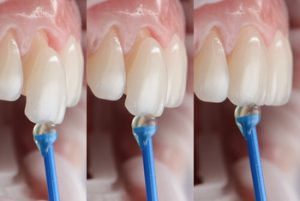
Are Porcelain Veneers Permanent? Understanding Longevity, Options, and Expectations
Porcelain veneers have become a go-to solution in cosmetic dentistry, offering dramatic results for those looking to improve the appearance of their smile. But one question continues to pop up in initial consultation appointments: Are porcelain veneers permanent?
The short answer is: Yes, porcelain veneers are considered a permanent solution to cosmetic dental issues, but that permanence comes with caveats worth exploring. In this comprehensive guide, we’ll unpack the meaning of “permanent” in this context, compare porcelain veneers to other types of dental veneers, and help you understand how to care for your investment for years to come.
Whether you’re worried about chipped teeth, tooth discolouration, or simply want a complete smile makeover, this article will provide the answers you need to make an informed choice.
What Are Porcelain Veneers?
Porcelain veneers are ultra-thin shells of medical-grade ceramic that are custom-designed to cover the front surface of your teeth. These restorations are tailored to each patient’s smile and applied using dental cement to create a seamless, natural look.
The procedure typically requires tooth preparation, where a small amount of the natural enamel is removed to accommodate the veneer. Once bonded, they can transform everything from crooked teeth and discoloured teeth to chipped teeth or small gaps.
Because of their durability, aesthetic quality, and ability to mimic the look of natural teeth, porcelain dental veneers are a popular choice in cosmetic dentistry.
Are Porcelain Veneers Permanent?

So, are porcelain veneers permanent in the way that dental implants are? No. But they are a long-term, irreversible procedure, as your natural tooth structure will be altered during placement. Once you get veneers, you will always need a form of restoration on those teeth involved.
Porcelain Veneers vs Composite Veneers
When deciding between veneers and other cosmetic options, it’s essential to compare the two main types: porcelain veneers and composite veneers (also called composite resin veneers). Both can enhance your smile, but they differ in material, cost, longevity, and maintenance.
Key Differences Between Porcelain and Composite Veneers:
Material:
- Porcelain veneers are crafted from durable, medical-grade ceramic that mimics the look and strength of natural teeth.
- Composite veneers are crafted from composite resin, the same material used in dental bonding procedures.
Lifespan:
- With the right care, porcelain veneers usually remain effective for 10 to 15 years.
- Composite veneers usually last around 4 to 8 years before needing replacement or repair.
Aesthetic Results:
- Porcelain offers a more translucent, natural look that closely mimics natural teeth.
- Composite veneers can look good but may not match the depth and light-reflecting qualities of porcelain.
Durability and Stain Resistance:
- Porcelain is stain-resistant and more durable against wear and tear.
- Composite resin is more porous, making it prone to staining and slightly less durable over time.
Application Time:
- Porcelain veneers generally require two visits. One for preparation and impressions, and one for final placement.
- Composite veneers can usually be applied in just one appointment, which makes them a quicker solution.
Repair Options:
- Porcelain veneers must be replaced if damaged, as they cannot be repaired.
- It’s relatively simple to repair or modify composite veneers, giving patients greater flexibility.
Which One Should You Choose?
If you’re after a permanent procedure with long-term value and a superior aesthetic result, porcelain veneers are often the best choice. However, if you’re looking for a budget-friendly, minimally invasive treatment, composite veneer options may be more suitable, especially for short- to mid-term smile improvements.
Tooth Preparation: What Makes Veneers Permanent?
The veneer’s permanent classification comes down to the tooth preparation process. For most traditional veneers, a thin layer of tooth enamel is removed, usually about 0.3 to 0.7 mm, to allow the veneer to bond securely and appear natural.
Because this alters your natural tooth structure, the procedure is considered irreversible. Once this enamel is removed, your teeth will always need to be covered, either with new veneers or another dental restoration, such as a dental crown.
For this reason, many dentists emphasise the need to make a well-informed choice before going ahead with permanent veneers.
Temporary Veneers: A Preview Before Commitment

- Protecting the prepped teeth
- Previewing your new smile
- Allowing adjustments to shape or shade
Temporary veneers are part of the process but are not designed to last. They give you the opportunity to see what your permanent solution will look like before full veneer placement.
How Many Teeth Should Get Veneers?
The number of teeth you include in a veneer treatment depends on your goals. For a full smile makeover, it’s common to veneer the top 6–10 teeth. The ones most visible when you smile. However, some people only get 2–4 tooth veneers to address isolated issues such as a chipped tooth, broken teeth, or gaps.
Your initial consultation will help determine how many teeth are involved and whether you’re a good candidate for porcelain veneers or an alternative.
Veneers Cover More Than Just Discolouration
While teeth whitening is ideal for general staining, it may not work on intrinsic stains (discolouration within the tooth). In these cases, porcelain veneers offer a more effective solution.
Porcelain veneers are capable of resolving various dental concerns, such as:
- Tooth discolouration that doesn’t respond to whitening treatments
- Chipped teeth or worn tooth structure
- Uneven teeth or gaps
- Mildly crooked teeth
- Teeth that are too small or irregular in shape
Because veneers are individually crafted in a dental laboratory, their size, shape, and colour can be customised to align with your facial features and smile objectives.
What Is the Process Like?
Here’s what to expect in a typical porcelain veneer journey:
1. Consultation Appointment
During your consultation appointment, the dentist will examine your teeth, take X-rays, and assess your cosmetic concerns. They’ll also discuss whether you’re better suited for composite bonding, teeth whitening, or traditional veneers.
2. Tooth Preparation
A thin layer of enamel is removed from the tooth’s surface to make room for the veneer. This ensures it sits flush with the surrounding normal teeth.
3. Temporary Veneers
Temporary veneers are applied while your final veneers are being crafted in a dental lab.
4. Veneer Placement
At the second visit, the porcelain veneer is tried on, adjusted, and then permanently bonded using a high-quality dental cement.
Caring for Porcelain Veneers: Oral Hygiene Tips
Just because porcelain veneers are stain-resistant and strong doesn’t mean you can skip your oral hygiene routine. Veneers protect the front surface, but the back and sides of your natural teeth are still exposed to decay and gum disease.
Follow these tips to maintain your veneers and overall oral health:
- Use a soft-bristled toothbrush and non-abrasive fluoride toothpaste
- Make flossing a daily habit to clear away plaque and leftover food particles.
- Avoid using teeth to open packages or chew hard items
- Visit your dentist’s office every 6 months for check-ups and cleans
Practising good oral hygiene not only protects your veneers but also supports the health of your gums and the longevity of your natural tooth structure.
What Happens If a Veneer Chips or Falls Off?
Although porcelain veneers are incredibly durable, they’re not indestructible. A blow to the mouth, grinding your teeth, or biting into hard foods could potentially damage or dislodge them.
If this happens:
- Contact your dentist immediately
- Keep the broken piece (if available)
- Don’t attempt to fix it yourself
Depending on the extent of the damage, the veneer may be rebonded or replaced entirely. In some cases, a dental crown may be necessary to restore teeth with significant structural loss.
Can Veneers Be Whitened Like Natural Teeth?

Unlike tooth enamel, the materials used in dental veneers, whether porcelain veneer or composite resin veneers, are stain-resistant and maintain their colour over time. That’s one of their biggest advantages in cosmetic dentistry. However, it also means that if your surrounding natural teeth discolour, the veneers won’t match unless you address the difference with your dentist.
What If You Want Whiter Teeth First?
If you’re hoping for a brighter smile, it’s often recommended to undergo teeth whitening before veneer placement. This allows the dentist to match your veneers to your desired tooth shade. Once the veneers are custom-made in the dental lab, their colour is locked in.
If your tooth veneers start to look dull due to stains on surrounding natural teeth, you may need new veneers or additional whitening for the uncovered areas.
Key Takeaway:
- Veneers cover only the front surface, not the entire tooth.
- You cannot whiten permanent veneers or temporary veneers using bleaching agents.
- Always discuss your ideal tooth shade during your initial consultation.
- Good oral hygiene with a non-abrasive fluoride toothpaste and a soft-bristled toothbrush helps maintain long-term brightness.
This is why planning your smile makeover carefully, including the possibility of whitening treatments, is essential before committing to any permanent solution.
Are Veneers Right for Everyone?
Veneers are an excellent option for many people, but they aren’t for everyone. You may not be an ideal candidate if you:
- Have active gum disease or poor oral hygiene
- Grind your teeth (bruxism) excessively
- Lack of sufficient tooth enamel for bonding
- Want a reversible treatment
In these cases, alternatives like composite bonding, teeth whitening, or orthodontics may be more suitable.
Porcelain Veneers Longevity: How to Extend Their Lifespan
While not eternal, permanent veneers can last well over a decade with the right care. Here are some tips to maximise their lifespan:
- Avoid foods and habits that could cause chipped teeth
- Wear a mouthguard at night if you clench or grind
- Stick to your dentist’s recommended care plan
- Replace veneers proactively before problems arise
Remember, although veneers are permanent, they may need replacement after 10–15 years. The better you care for them, the longer you’ll enjoy their benefits.
Conclusion: Are Porcelain Veneers Permanent?
In summary, porcelain veneers are considered permanent because they involve an irreversible procedure that alters your tooth enamel. Once placed, they cannot be removed without replacement, making them a long-term commitment.
That said, they are not forever. With excellent oral hygiene, regular dental visits, and avoiding damaging habits, you can expect them to last well over a decade. They are a transformative, life-enhancing option for those looking to correct cosmetic concerns and achieve a truly smile-worthy result.
If you’re unsure whether porcelain veneers are right for you or want expert guidance on achieving a long-lasting, natural-looking smile, book a consultation with us at Pearl Dental Care or call 02 9158 6312. Our experienced team is here to answer your questions, walk you through the process, and help you take the next step toward a confident smile.
Resources
Watson, S. (2024). ‘Gingivitis and Periodontal Disease (Gum Disease)’. WebMD, 9 February. New York, NY: WebMD LLC. https://www.webmd.com/oral-health/gingivitis-periodontal-disease
WebMD Editorial Contributors. (2023). ‘Teeth Bonding’. WebMD, 2 April. New York, NY: WebMD LLC. https://www.webmd.com/oral-health/dental-bonding
WebMD Editorial Contributors. (2023). ‘Tooth Enamel Erosion and Restoration’. WebMD, 4 April. New York, NY: WebMD LLC. https://www.webmd.com/oral-health/tooth-enamel-erosion-restoration
WebMD Editorial Contributors. (2024). ‘Dental Crowns’. WebMD, 15 October. New York, NY: WebMD LLC. https://www.webmd.com/oral-health/dental-crowns


 Dental tourism is the practice of travelling abroad to receive dental treatments, often at a fraction of the cost compared to local services. Popular destinations like Bali, Thailand, and the Philippines attract patients seeking affordable options for procedures such as dental veneers, implants, and cosmetic dentistry. Beyond cost savings, dental tourism offers the unique appeal of combining necessary dental care with the chance to explore exotic locations. However, while the promise of a new smile and a tropical getaway may be tempting, it’s essential to weigh the potential risks and hidden costs associated with
Dental tourism is the practice of travelling abroad to receive dental treatments, often at a fraction of the cost compared to local services. Popular destinations like Bali, Thailand, and the Philippines attract patients seeking affordable options for procedures such as dental veneers, implants, and cosmetic dentistry. Beyond cost savings, dental tourism offers the unique appeal of combining necessary dental care with the chance to explore exotic locations. However, while the promise of a new smile and a tropical getaway may be tempting, it’s essential to weigh the potential risks and hidden costs associated with Australian dental clinics
Australian dental clinics  If you are considering cosmetic procedures as veneers, it’s essential to conduct thorough research and prioritise clinics with a strong reputation for quality care. Whether you choose porcelain or composite veneers, understanding the materials, procedures, and aftercare involved will help you make an informed decision. Australian dental clinics excel at ensuring a seamless experience, from consultation to follow-up care, making them an ideal choice for those seeking a confident and radiant smile.
If you are considering cosmetic procedures as veneers, it’s essential to conduct thorough research and prioritise clinics with a strong reputation for quality care. Whether you choose porcelain or composite veneers, understanding the materials, procedures, and aftercare involved will help you make an informed decision. Australian dental clinics excel at ensuring a seamless experience, from consultation to follow-up care, making them an ideal choice for those seeking a confident and radiant smile.